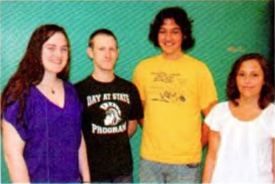Materials Science
Projects
For 2012, the six teams are conducting the following failure analysis investigations:
Players: Failure by Crack Propagation in Al-Alloy Softball Bat
Macroscopic examination of the aluminum softball bat showed multiple crack fractures spanning the length of the barrel to the top of the handle. Preliminary FAI results also indicated that the failure occurred by a brittle fracture mode. Early assessment suggested that factors associated with materials selection and manufacturing processes are at issue.
Spartan: Carver Bench-Top Laboratory Bolster Platen Failure
Vendor information and specifications rate the bench-top press at a 12-ton limit. Initial examination showed the cross-bar press platen failed by crack initiation on its top surface. The extent of cracks noted in the failure suggested the system was loaded to high stress level. Several approaches are under consideration including overloading misalignment and material integrity.
Team Seven: Outdoor Sprinkler System Brass Gate Valve Fracture
Macroscopic visual examination showed that failure of the brass gate valve and its body was due to crack propagation possibly due to stress corrosion cracking (SCC). The valve system was exposed to seasonal temperature changes (0 – 90 F) and to the elemental chemistry and deposits of tap water. Material degradation (@ dezincification) is being considered as a possible failure source.
Arctic Pandas: Failure of Rear Brake Rotor – 2002 Jeep Grand Cherokee
Visual examination revealed failure by cracking of the brake rotor. The fracture occurred
at the joining of the rotor flange and hub. The rotor was manufactured from graphite- flaked cast iron and the nature of the fracture was brittle. Preliminary evidence suggested that the main, critical crack initiation site for the rotor was due to premature nucleation of micro-cracks at graphite flake agglomerates in the material.
Failures: Failure of A Cadillac ATS Steel Propshaft Sub-Assembly
The Alpha propshaft rear assembly failed under cyclic torsional loading prior to the loading life cycle requirement. The function of this shaft is for power transmission to the rear drive module. Several joining techniques were apparently used to assemble the propshaft couplings. The most prominent joining methods are spot and friction welding. Consequently, welding-related manufacturing issues are being critically investigated.
Leopard: Fracture Analysis of a Bowl Die Used in 15-Ton Hydraulic Press
The M4 tool-steel bowl die is installed in a high-capacity 15-ton hydraulic press. The die is used to stamp parts for the steering column in the automobile industry. Brittle fracture failure of the bowl die assembly occurred after only 3.500 of the specified 10,000 stamping cycles. Examination of the fracture surface indicates rapid crack propagation during the failure as some evidence of Wallner lines was apparent.





